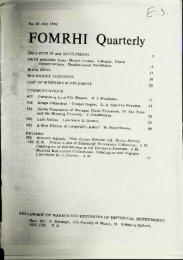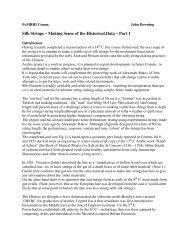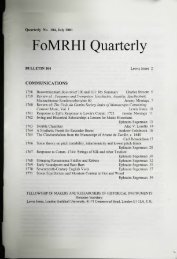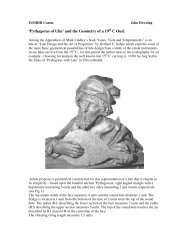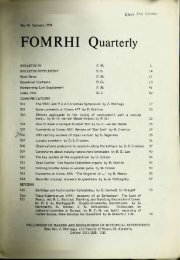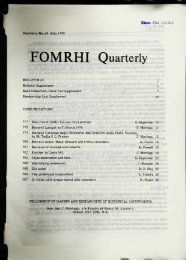•rf - FoMRHI
•rf - FoMRHI
•rf - FoMRHI
You also want an ePaper? Increase the reach of your titles
YUMPU automatically turns print PDFs into web optimized ePapers that Google loves.
There is some evidence indicating that the consort-of-six, written for in<br />
Morley's and Rosseter's Consort Lessons ( io) seems to have been intended for use<br />
at either pitch standard, presumably since it mixed instruments normally at<br />
different standards. A small treble lute appropriate for the Cammerthon standard<br />
was specified on both title pages. The treble violin, cittern and bandora were ali<br />
at their normal pitches At Cammerthon pitch a particularly small bass viol of 72 cm<br />
string length was needed, and if early 17th century viols had the same distribution<br />
of string lengths as the later ones that Talbot described, a lyra viol would have been<br />
appropriate. The illustration of this consort in the Henry Union painting (11) shows<br />
the bass viol played in a way particularly appropriale for lyra-style music, i.e. a<br />
short bow striking the strings only at the beginning of a note letting the strings<br />
resonate afterwards rather like on a lute. Mace later in the century indicated a<br />
similar flexibility by prescribing the use of the leero-viol as a division viol. At the<br />
alternative tone _ low standard, normal treble and bass viols would be used. The<br />
cittern can be tuned a tone down with no problem of strings becoming unusablc.<br />
The bandora's seventh course does become unusablc tuned a Ione down so the music<br />
carefully avoids ever using the seventh course. The treble lute could be tuned a tone<br />
down with no problem since only six courses were used in this music. A mean lute<br />
could have been used as well. We have no data about fiuto or recorder technique or<br />
pitch standards in England at the time, and so cannot discuss the probabilitics of<br />
either using different instruments a tone apart or transposing.<br />
When violins played with viol consorts in the 17th century, it is possible<br />
that they were adjusted especially for the lower pitch standard. This adjustment is<br />
evident in many 17th and 18th century paintings of violins playing with lutes ( eg. fig.<br />
237, 238 and 245 of Buchner lst ed.) (13) , in which the bridge is moved down the<br />
soundboard away from between the nicks in the f-holes towards the tailpiece( 14-).<br />
If the soundpost remained in the same place,this bridge placemcnt.on the other side<br />
of and further from the soundpost, would give a weaker tone, an asset in balancing<br />
with weaker-toned instruments. When violins played with only bass viols, the use of<br />
leero-viols at Cammerthon would be a viable alternative.<br />
17th CENTURY ENGLISH CHURCH PITCHES<br />
Church organs and bells of identified pitch reprcsent the only other data we<br />
know of concerning 17th century English pitch standards. Of the half dozen such<br />
organs and bellsincluded in Ellis's large list (15), ali but one are well within a semitone<br />
semitone of Cammerthon. The exception is a 1683 organ at Durham which is almost<br />
exactly a tone higher. Praetorius mentioned that some old organs were tuned a tone<br />
or a tone and a half above Cammerthon. Thomas and Rhodes suggest that high pitches<br />
could be a disease of organ old-age. When Nathaniel Tomkins published his father<br />
Thomas's 'Musica Deo Sacra' in 1668 (16), he included a statement of absolute<br />
tempo and pitch: semibreve - 36 M.M. and a tenor F organ pipe is 2^ feet long.<br />
The latter leads to a' = 474 Hz, a tone above Cammerthon. The organ al Worcester<br />
Cathedral that his father played on and was very attached to was rebuilt to Cammerthon<br />
standard (15) between Thomas Tomkins' death in 1556 and the publication of 'Musica<br />
Deo Sacra', possibly as a result of damage during the second seige of Worcester.<br />
Nathaniel's nostalgia is understandable. Thomas Tomkins' high-pitched organ was<br />
built in 1613-14. (17) It is not inconceivable that Praetorius in 1619 was reacting to<br />
knowledge of this organ as well as perhaps other aberrant high-pitched new organs<br />
when he was advocating a universal Cammerthon standard. The pitch of ita replacement<br />
shows that his view was widely held in the 17th century,<br />
-3S"-





